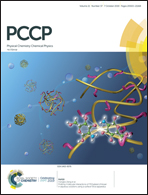Growth of highly oriented MoS2via an intercalation process in the graphene/SiC(0001) system
Abstract
A method of growing highly oriented MoS2 is presented. First, a Mo film is deposited on a graphene/SiC(0001) substrate and the subsequent annealing of it at 750 °C leads to intercalation of Mo underneath the graphene layer, which is confirmed by secondary ion mass spectrometry (SIMS) measurements. Formation of highly oriented MoS2 layers is then achieved by sulfurization of the graphene/Mo/SiC system using H2S gas. X-ray diffraction reveals that the MoS2 layers are highly oriented and parallel to the underlying SiC substrate surface. Further SIMS experiments reveal that the intercalation process occurs via the atomic step edges of SiC and Mo and S atoms gradually diffuse along SiC atomic terraces leading to the creation of the MoS2 layer. This observation can be explained by a mechanism of highly oriented growth of MoS2: nucleation of the crystalline MoS2 phase occurs underneath the graphene planes covering the flat parts of SiC steps and Mo and S atoms create crystallization fronts moving along terraces.



 Please wait while we load your content...
Please wait while we load your content...